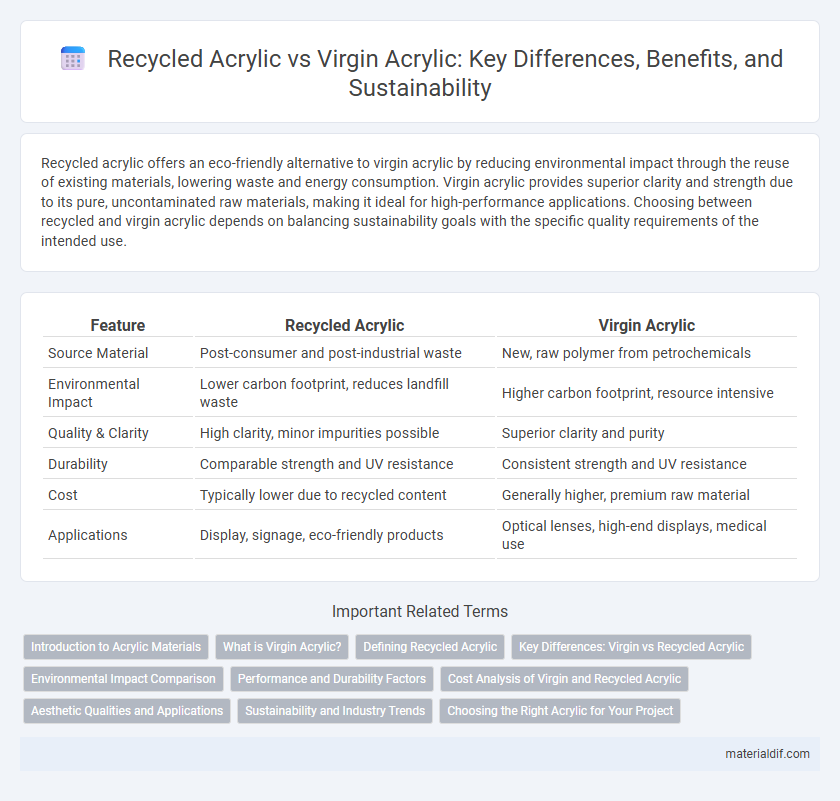Recycled acrylic offers an eco-friendly alternative to virgin acrylic by reducing environmental impact through the reuse of existing materials, lowering waste and energy consumption. Virgin acrylic provides superior clarity and strength due to its pure, uncontaminated raw materials, making it ideal for high-performance applications. Choosing between recycled and virgin acrylic depends on balancing sustainability goals with the specific quality requirements of the intended use.
Table of Comparison
| Feature | Recycled Acrylic | Virgin Acrylic |
|---|---|---|
| Source Material | Post-consumer and post-industrial waste | New, raw polymer from petrochemicals |
| Environmental Impact | Lower carbon footprint, reduces landfill waste | Higher carbon footprint, resource intensive |
| Quality & Clarity | High clarity, minor impurities possible | Superior clarity and purity |
| Durability | Comparable strength and UV resistance | Consistent strength and UV resistance |
| Cost | Typically lower due to recycled content | Generally higher, premium raw material |
| Applications | Display, signage, eco-friendly products | Optical lenses, high-end displays, medical use |
Introduction to Acrylic Materials
Recycled acrylic is made from post-consumer or post-industrial scrap, reducing environmental impact by minimizing waste and lowering carbon emissions compared to virgin acrylic, which is synthesized from raw petrochemicals through polymerization of methyl methacrylate monomers. Virgin acrylic offers high clarity, durability, and consistency in molecular weight, making it ideal for precision applications, whereas recycled acrylic may exhibit slight variations in color and strength due to the reprocessing methods. Both materials share properties such as UV resistance, lightweight nature, and excellent weatherability, but the choice between recycled and virgin acrylic depends on sustainability goals and performance requirements.
What is Virgin Acrylic?
Virgin acrylic is a high-quality synthetic polymer derived from polymerized methyl methacrylate monomers, produced without any recycled content. It offers superior clarity, durability, and resistance to UV degradation compared to recycled acrylic, making it ideal for applications requiring pristine transparency and long-lasting performance. Manufacturers favor virgin acrylic for optical lenses, signage, and high-end displays due to its consistent molecular structure and enhanced physical properties.
Defining Recycled Acrylic
Recycled acrylic is produced by reprocessing post-consumer or post-industrial acrylic waste, reducing environmental impact by minimizing raw material extraction and landfill contributions. Unlike virgin acrylic, which is synthesized from new petrochemical feedstock, recycled acrylic retains comparable clarity and durability while promoting sustainability in manufacturing. This eco-friendly alternative supports circular economy initiatives by recovering valuable polymers without compromising product quality.
Key Differences: Virgin vs Recycled Acrylic
Virgin acrylic is created from pure, raw materials, offering superior clarity, strength, and color consistency, making it ideal for high-quality applications. Recycled acrylic is produced by reprocessing scrap or post-consumer acrylic, providing an eco-friendly alternative with slightly reduced optical properties and structural integrity. Key differences lie in environmental impact, cost efficiency, and performance, with virgin acrylic excelling in durability and recycled acrylic supporting sustainability goals.
Environmental Impact Comparison
Recycled acrylic significantly reduces environmental impact by lowering carbon emissions and minimizing plastic waste compared to virgin acrylic, which relies heavily on fossil fuels and energy-intensive production processes. The use of recycled acrylic helps conserve natural resources and decreases landfill accumulation, promoting circular economy principles in the acrylic industry. While virgin acrylic offers consistent quality, recycled acrylic advances sustainability goals through its reduced ecological footprint and resource efficiency.
Performance and Durability Factors
Recycled acrylic maintains comparable clarity and UV resistance to virgin acrylic but may exhibit slightly reduced impact strength and chemical resistance due to polymer chain degradation during recycling. Virgin acrylic typically offers superior scratch resistance and greater tensile strength, ensuring enhanced durability for long-term applications. Both materials provide excellent weatherability, but virgin acrylic outperforms recycled variants in consistent performance under extreme environmental conditions.
Cost Analysis of Virgin and Recycled Acrylic
Recycled acrylic offers a cost-effective alternative to virgin acrylic by significantly reducing raw material expenses, often decreasing production costs by up to 30%. Virgin acrylic maintains higher purity and clarity, justifying its premium price, which can be 20-50% more expensive due to energy-intensive polymerization processes and fresh monomer usage. Companies balance cost savings from recycled content against the quality demands of end-use applications when choosing between recycled and virgin acrylic materials.
Aesthetic Qualities and Applications
Recycled acrylic displays slight variations in color clarity and surface finish compared to virgin acrylic, often featuring a more muted or frosted appearance ideal for decorative applications where sustainability is prioritized. Virgin acrylic offers superior optical clarity and consistent gloss, making it the preferred choice for high-end displays, signage, and lighting fixtures demanding flawless aesthetics. Both materials are versatile but choosing recycled acrylic supports eco-friendly design without significantly compromising visual appeal in less critical applications.
Sustainability and Industry Trends
Recycled acrylic significantly reduces environmental impact by lowering carbon emissions and minimizing landfill waste compared to virgin acrylic, which relies on petroleum-based raw materials. Industry trends highlight a growing demand for sustainable materials, with manufacturers increasingly adopting recycled acrylic to meet eco-conscious consumer preferences and regulatory requirements. Innovations in recycling technology are enhancing the quality and availability of recycled acrylic, making it a viable and sustainable alternative in textile, signage, and automotive industries.
Choosing the Right Acrylic for Your Project
Recycled acrylic offers an eco-friendly alternative with reduced environmental impact, using post-consumer or industrial waste to create new sheets while maintaining durability and clarity similar to virgin acrylic. Virgin acrylic, produced from raw petrochemical materials, typically provides superior optical clarity, strength, and customization options, ideal for projects demanding high-performance characteristics. Selecting the right acrylic depends on project requirements, balancing sustainability goals with desired material properties such as transparency, impact resistance, and cost.
Recycled Acrylic vs Virgin Acrylic Infographic

 materialdif.com
materialdif.com